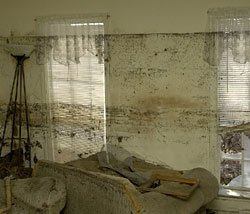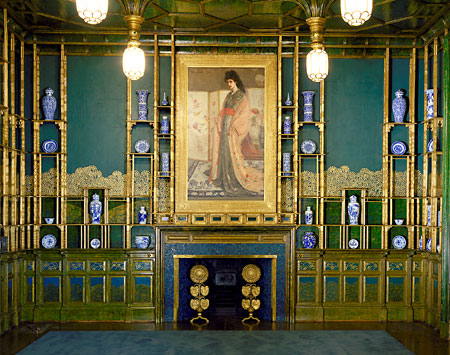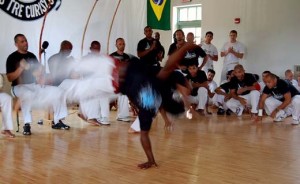August 31, 2009
Hurricane Katrina: The Recovery of Artifacts and History

The mailbox in this photograph, which is currently on display at the National Museum of American History, was all that was left of the a home in the Lower Ninth Ward. Photo courtesy of the National Museum of American History.
This week marks the four-year anniversary of the nation’s fifth deadliest hurricane, Katrina, the devastating storm that flooded New Orleans and ravaged coastal areas from central Florida to Texas.
On September 26 that year, two Smithsonian staffers from the National Museum of American History, curator David Shayt and photographer Hugh Talman began a five day research expedition, traveling throughout Louisiana and Mississippi collecting artifacts and photo documenting the disaster areas. (Shayt later wrote about his experience in the December 2005 issue of Smithsonian magazine. He died in 2008.)
At the evacuation center in Houma, Louisiana, Shayt and Talman met Bryan and Beverly Williams, who gave the museum staffers permission to travel to their New Orleans home in Ward 7—escorted for safety reasons by two police officers—to recover objects important to the family and to search for possible artifacts for the museum’s collections.
Brent Glass, the museum’s director, noted at the time that it was important to “collect, preserve and document this episode in the country’s history.”
For Shayt, the visit was a powerful experience. Upon entering the house, the curator wrote of the scene he encountered. “We entered the sodden ground floor and found the furniture all scrambled about as if it had been swirled in a colander with mud.”
Lace valances, handmade by Beverly, caught his eye. “The pair of valances—a delicate, ghastly symbol of the flood and bearing Katrina’s signature flood-line mark, would make a powerful artifact,” Shayt wrote. For the family, Shayt and Talman recovered the Williams’ daughter’s Playstation 2 and DVD collection and a number of family photographs for Beverly.

The lace valances salvaged from the Williams house in New Orleans are a powerful addition to the museum's collection. Photo courtesy of the museum.
Shayt also recalled driving into Terrebonne Parish, Louisiana, on the first day of the trip and seeing a large plywood sign with a poignant message: “Have We Been Forgotten.” As he contemplated adding the sign to his growing collection of artifacts for the museum that day, he noted his own wary decision-making process. “Disaster collecting is an inexact science. The selection process is daunting, but objects like this sign exist to make the telling of history possible.” The sign now resides within the museum’s collection.
Shayt and Talman collected more than 20 artifacts and took 900 photographs for the museum. Other artifacts include a sign from New Orlean’s Broad Street reading “Hurricane Evacuation Route,” a cot from the Superdome and a mailbox from a home in New Orleans that is currently on display in the first floor glass cases, or Artifact Walls, located at the Constitution Avenue entrance.
Smithsonian Events for the Week of August 31-September 4: Dig It!, The Scurlock Studio, Asia After Dark and More!

The Peacock Room (1877) by James McNeill Whistler. Image courtesy of the Freer Gallery of Art.
Monday, August 31: Summertime, and the living is easy—there may not be any special events going on today, but there are plenty of regularly-scheduled goings-on around the Smithsonian that are sure to entertain. From animal feedings to museum tours, there’s lots of free fun to be had!
Tuesday, September 1: Dig It! Activities
Experience the Natural History Museum’s Dig It! exhibition a la carte! As you tour the show, keep an eye out for volunteers who will be stationed by carts carrying fun activities. They will be available to answer your questions as well as engage you in special, educational activities to enhance your experience of the exhibit. Free. Natural History Museum, 11:00 AM-2:00 PM
Wednesday, September 2: The Scurlock Studio and Black Washington
A docent will take you on a tour of the photography exhibition, The Scurlock Studio and Black Washington. The show celebrates and document’s black Washington DC through almost a century’s worth of photographs. Free. American History Museum, 10:30 AM
Thursday, September 3: Asia After Dark
Kick off your weekend in style with an evening of artwork and cocktails at the Freer and Sackler galleries! Tonight’s event highlights the Peacock Room—so come on out and strut your stuff to the sounds of DJs Yellow Fever, enjoy dancing by Boogie Bots and short films from the DC Asian Pacific American Film Festival. Advance tickets have sold out; however, tickets will be available at the door. Rate is $20 per ticket. Doors open at 6:30 PM. Freer, 6:30-10:30 PM.
Friday, September 4: Looking at Baselitz and Guston, Part II: In Conversation
Hirshhorn associate curator Kristen Hileman and The Phillips Collection curator of modern and contemporary art Vesela Sretenovic lead a two-part discussion on the figure in contemporary art. Works by Georg Baselitz and Philip Guston are currently featured in both Strange Bodies at the Hirshhorn and Paint Made Flesh at The Phillips. Free. Hirshhorn, 12:30-1:30 PM. Part I of this free lecture series takes place on Thursday, September 3 at the Hirshhorn at 6:30 PM.
August 28, 2009
Weekend Events: Dance Festival, Forensics and the Scurlock Studio
Dancer's Series: Steps (1979) by Jack Mackie. Image courtesy of the Smithsonian American Art Museum.
Friday, August 28: Forensic Friday
Join Smithsonian forensic anthropologists as they study new cases from America’s historic past. Take advantage of this opportunity to ask the forensic anthropologists questions and observe first-hand the basic methods used for documenting human remains recovered from archaeological investigations. Relates to the exhibit Written in Bone, which was recently covered in Smithsonian. Free. Natural History Museum, 1:00 PM
Saturday, August 29: Dance DC Festival
You can dance, you can jive—having the time of your life at the 6th annual Dance DC Festival. This year, the American Indian Museum is hosting performances by CapoeiraDC—a group that blends martial arts with their dance moves—and Hui O Ka Pua `Ilima showing off the traditional and modern moves of Hawaii, Tahiti and New Zealand. Free, but seating is first come, first served. American Indian Museum, 12:00 PM
Sunday, August 30: The Scurlock Studio and Black Washington
A docent will take you on a tour of the photography exhibition, The Scurlock Studio and Black Washington. The show celebrates and document’s black Washington DC through almost a century’s worth of photographs. Free. American History Museum, 10:30 AM
For more information on events and exhibitions at the Smithsonian museums, check our companion website, goSmithsonian.com, the official visitor’s guide to the Smithsonian.
Capoeira: A Dance, a Play or a Fight?

Capoeira, an Afro-Brazilian martial arts, was developed in Brazil about in the 1600s. Photograph courtesy of CapoeriaDC
Ren Powell, the director of Capoeira Males, will join members of his Washington, D.C., based studio at the National Museum of the American Indian as part of the city-wide D.C. Dance Festival this Saturday. I spoke with Powell about this unique dance form and where it comes from.
So, what is Capoeira?
It is a game, it is a dance, it is play, it is fight. It is all those things.
Where did it come from?
It was just a resistance to colonialism, just like how reggae was created in Jamaica, and over here in the United States, in New Orleans, there was jazz. Eventually different forms of manifestations of inherent movement turn into stuff like break dancing. So that’s how Capoeira really came about. It’s just a combination of the different arts that the enslaved Africans brought with them. After colonialism and slavery was outlawed, a lot of people who had escaped into the mountains with their different techniques came into the inner cities and started developing schools in the northeast of Brazil. That’s where a lot of the contemporary Capoeira that you see today developed.
Tell me about your studio, Capoeira Males.
The group’s not just run by a hierarchy system, but it’s run by people strengths. One of my main students, she’s an economist so naturally managing money and the non-profit is her role. It just works like clockwork.
Your Web site says that Capoeira is a “means of liberation from the barriers people impose on themselves.” Can you elaborate on that?
It is a means of self discovery in terms of you learning about yourself. Whenever someone puts themselves through the ringer, whether it be like boot camp, joining the army, going to four years of university, one develops the ability to stick to something and to become calloused to failure. Those things help you to learn about yourself because you learn where your weak points are, you learn what your strengths are. You capitalize on your strengths and learn to develop your weaknesses in order to become a more balanced person.
Even though Capoeira is a form of martial arts, you say “to play” Capoeira. Why?
The word “play” Capoeira came about because during the colonial period when the enslaved Africans were on those plantations, there were head men walking around, guys that were in charge of the enslaved Africans. I don’t think you’d want to go back to the big guy in the big house and say, “A couple of your subjects are down there fighting and practicing with these machetes and all this other stuff.” They developed the terminology to kind of disguise the intention of the game as well as the development of what was being developed. You will notice that most of the words in Capoeira are non-violent terminology. We play the game of Capoeira as opposed to the war and the fights. That kind of terminology isn’t used. It has become part of the trickery, the word we use is called malicia. Part of the malicia of Capoeira is to sell someone a six for a nine, literally.
Capoeria reminds me a little of break dancing. Am I way off with that comparison?
The thing about a lot of African-based dance, performance or community events, is they’re usually done in circles. Some break dancers come to our Capoeira classes to learn a lot of new movements. There are a lot of similarities. What happened is that break dancing is just a manifestation of an inherent movement of a people in one area versus another area.
Everyone gets a Capoeira nickname. What’s yours?
My Capoeira nickname is Morego. And it means bat. It’s because I am a night person. I love the night. I come alive at night. My Capoeira master came out here to D.C. from Seattle and hung out with us and trained us for awhile, and he noticed that I was always exuberant at night. So he’s like, “You’re like a bat.” He’s very fast. He executes everything really fast. So his name is Corisco, which means lightning. When you see him play, you’re like, “That is lightning fast.”
When do people generally get their nicknames?
If your personality is exuberant and your personality is brilliant and you shine a lot, you can get your name the first day. That’s the things about Capoeira, you cannot hide who you are. Eventually people will get to know you based on the way you play. It’s just like when you work with someone in the office, and you get to know them from their habits. Some people disguise it longer and some people show you immediately. It just depends on the individual.
What about the future?
I can talk about Capoeira forever and ever and ever and ever. I’m completely an addict. It is just one of the most amazing things on this planet. I’m surprised that more people aren’t involved in it.
August 27, 2009
A Season of Classical Music Performances at the Smithsonian

The Budapest String Quartet (1941) by Joseph Wolins. Image courtesy of the Smithsonian American Art Museum.
If you visit the National Museum of American History, you may happen upon the Hall of Musical Instruments—a priceless collection of instruments from as far back as 300 years ago. But once in a while, these artifacts are let out of their display cases and are used in the way they were intended: for concert performances. That’s right. The white-gloved curators at the American History museum allow a select few to play with its toys—and oh what beautiful music they make! Now celebrating its 33rd season, the Smithsonian Chamber Music Society features the talents of four musical groups—the Axlerod String Quartet, the Castle Trio, the Smithsonian Chamber Players and the Smithsonian Chamber Orchestra—will be featured in a string of special concerts this fall. Check out the listings below and partake of the opportunities to hear Stradivarii and Steinways play the music they was designed to play.
Tickets are required for all concert events. Some concerts are preceded by a lecture. For information or to purchase tickets, call 202-633-3030 or visit online. The full schedule is after the jump.































